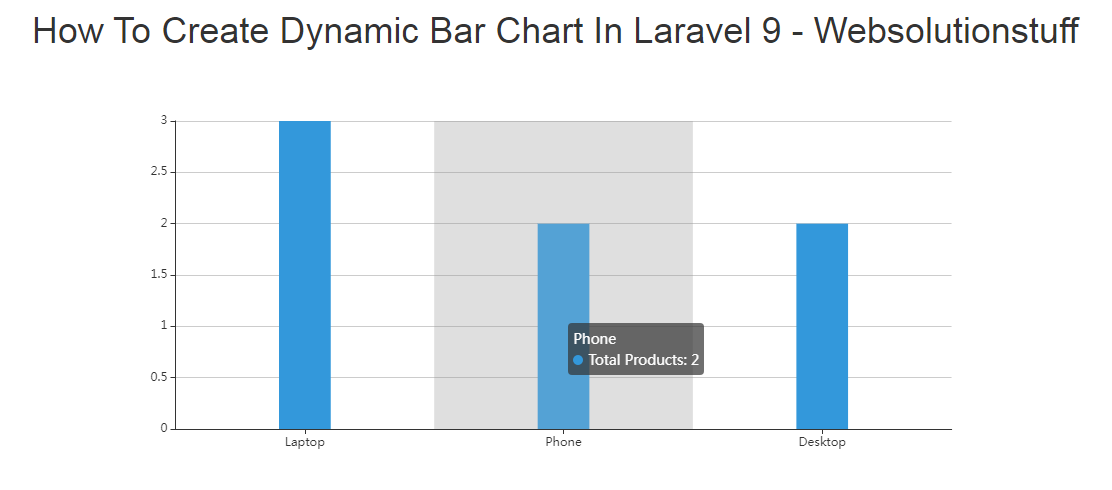How To Create Dynamic Bar Chart In Laravel 9
Websolutionstuff | Mar-21-2022 | Categories : Laravel PHP jQuery
In this article, we will see how to create a dynamic bar chart in laravel 9. Bar charts are used to represent data in graphics view. For the creation of a dynamic bar chart example, you need to create a route, controller, blade file, and database.
So, let's see dynamic bar chart in laravel 9, bar chart in laravel 9, laravel 9 bar chart js, dynamic charts in laravel 9, create dynamic bar chart in laravel 9, bar chart in php.
Step 1 : Install Laravel 9 For Dynamic Bar Chart
Step 2 : Create Migration Table
Step 3 : Add Route
Step 4 : Create Controller And Model
Step 5 : Add Code In Controller
Step 6 : Create Blade File For Dynamic Bar Chart
In this step, we will create the laravel 9 project using the below command.
composer create-project --prefer-dist laravel/laravel barchart
After project setup, we need dynamic data for the bar chart example. So, we have to create migration for the "product" table using the below command.
php artisan make:migration create_products_table --create=products
After run this command you will find the PHP file on location "database/migrations/". And in this file add the below code.
<?php
use Illuminate\Database\Migrations\Migration;
use Illuminate\Database\Schema\Blueprint;
use Illuminate\Support\Facades\Schema;
class CreateProductTable extends Migration
{
/**
* Run the migrations.
*
* @return void
*/
public function up()
{
Schema::create('product', function (Blueprint $table) {
$table->id();
$table->string('name')->nullable();
$table->integer('price')->nullable();
$table->integer('year')->nullable();
$table->string('product_type')->nullable();
$table->timestamps();
});
}
/**
* Reverse the migrations.
*
* @return void
*/
public function down()
{
Schema::dropIfExists('product');
}
}
After these changes we need to run this migration by the following command in our terminal:
php artisan migrate
Now, add a route in the routes/web.php file.
<?php
use Illuminate\Support\Facades\Route;
use App\Http\Controllers\BarchartController;
/*
|--------------------------------------------------------------------------
| Web Routes
|--------------------------------------------------------------------------
|
| Here is where you can register web routes for your application. These
| routes are loaded by the RouteServiceProvider within a group which
| contains the "web" middleware group. Now create something great!
|
*/
Route::get('/', function () {
return view('welcome');
});
Route::get('bar-chart', [BarchartController::class,'barchart']);
After adding the route, we need to create a new controller and model for the bar chart example. So, type the below command for creating a controller.
php artisan make:controller BarchartController
php artisan make:model Product
Add below code in your app\Http\Controllers\EchartController.php file.
<?php
namespace App\Http\Controllers;
use Illuminate\Http\Request;
use App\Product;
class BarchartController extends Controller
{
public function barchart(Request $request)
{
$Laptop = Product::where('product_type','Laptop')->get();
$Phone = Product::where('product_type','Phone')->get();
$Desktop = Product::where('product_type','Desktop')->get();
$laptop_count = count($Laptop);
$phone_count = count($Phone);
$desktop_count = count($Desktop);
return view('barchart',compact('laptop_count','phone_count','desktop_count'));
}
}
Add below code in your Product Model in app\Models\Product.php file.
<?php
namespace App;
use Illuminate\Database\Eloquent\Model;
class Product extends Model
{
protected $guarded = [];
}
In this step, we are creating a barchart.blade.php file for view.
<!DOCTYPE html>
<html>
<head>
<meta charset="utf-8">
<meta http-equiv="X-UA-Compatible" content="IE=edge">
<title>How To Create Dynamic Bar Chart In Laravel 9 - Websolutionstuff</title>
<link rel="stylesheet" href="https://maxcdn.bootstrapcdn.com/bootstrap/3.3.7/css/bootstrap.min.css">
<link href="{{asset('assets/css/components.min.css')}}" rel="stylesheet" type="text/css">
<script src="https://cdnjs.cloudflare.com/ajax/libs/jquery/3.6.0/jquery.min.js" crossorigin="anonymous" referrerpolicy="no-referrer"></script>
<script src="https://cdnjs.cloudflare.com/ajax/libs/echarts/5.3.1/echarts.min.js" crossorigin="anonymous" referrerpolicy="no-referrer"></script>
</head>
<body>
<div class="col-md-12">
<h1 class="text-center">How To Create Dynamic Bar Chart In Laravel 9 - Websolutionstuff</h1>
<div class="col-md-8 col-md-offset-2">
<div class="col-xl-6">
<div class="card">
<div class="card-body">
<div class="chart-container">
<div class="chart has-fixed-height" id="bars_basic"></div>
</div>
</div>
</div>
</div>
</div>
</div>
</body>
</html>
<script type="text/javascript">
var bars_basic_element = document.getElementById('bars_basic');
if (bars_basic_element) {
var bars_basic = echarts.init(bars_basic_element);
bars_basic.setOption({
color: ['#3398DB'],
tooltip: {
trigger: 'axis',
axisPointer: {
type: 'shadow'
}
},
grid: {
left: '3%',
right: '4%',
bottom: '3%',
containLabel: true
},
xAxis: [
{
type: 'category',
data: ['Laptop', 'Phone','Desktop'],
axisTick: {
alignWithLabel: true
}
}
],
yAxis: [
{
type: 'value'
}
],
series: [
{
name: 'Total Products',
type: 'bar',
barWidth: '20%',
data: [
{{$laptop_count}},
{{$phone_count}},
{{$desktop_count}}
]
}
]
});
}
</script>
Output :

You might also like :
- Read Also: Laravel 9 AJAX CRUD Example
- Read Also: How To Get Hourly Data In MySQL
- Read Also: Laravel 9 CRUD Operation Example
- Read Also: Laravel 9 Import Export CSV/EXCEL File Example
Recommended Post
Featured Post

Laravel 10 Delete Multiple Rec...
In this article, we will see laravel 10 delete multiple records using the checkbox. Here, we will learn about how to del...
Mar-03-2023

How to Validate Reactive Form...
Hello developer, In this article, we'll see how to validate a reactive form in angular 17. Reactive forms...
Mar-27-2024

Laravel 8 Image Upload Validat...
In tutorial we will see how to validate laravel 8 image upload validation. In laravel 7/8 you can validate image using t...
Dec-15-2021

How To Get Selected Checkbox L...
In this tutorial, I will explain you to how to get the selected checkbox value from a checkbox list in jquery, If y...
Jun-17-2020